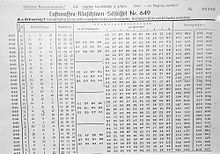Keys
Keys is a general term used in cryptology for encryption and decryption .
A person's messages encrypted , so encrypted or decrypted, is in the jargon as Schlüssler (also: cipher ), respectively.
use

The verb generally stands for converting plain text into ciphertext depending on a cryptographic key and vice versa for converting ciphertext into plain text. (The two terms plain text and ciphertext stand here symbolically for any type of data, not just text in the classic sense, but also, for example, for sound files , image files or video files .)
In particular written messages or radio messages , a distinction between the hand keys , so the manual, for example, with pencil and paper, carried out encryption or decryption, and the mechanical keys in which a key machine is used (summarizing term for encryption and decryption machine).
Key room
The room in which encryption is carried out is referred to in jargon as the key room (picture above) ( English cipher room ) or also as the encryption room , rarely also as the encryption room .
Other uses of the term
In addition to the key machine and key space, the term is also used in other compound words such as key alphabet , key instructions (see also Enigma key instructions ), key setting, key device , key circle, key material, key means, key network (see also key network Triton ), key board (picture below) , key documents , Key procedure, key regulation and key slip.
literature
- OKM : The key M –Procedure M General. M.Dv. ( Marine service regulation ) No. 32/1, Berlin 1940, p. 13. PDF; 3.2 MB , accessed on November 19, 2018.
- Andreas Sauer: Pfaffenhofen town history (s). Cold War in Pfaffenhofen. The basic network switching and switching center of the Bundeswehr (GSVBw66) and its history. Pfaffenhofen an der Ilm 2014, p. 34. PDF; 7.2 MB , accessed on November 19, 2018.
Web links
- Jürgen Rohwer : Radio reconnaissance and its role in World War II PDF; 7.4 MB , accessed September 14, 2017
- Key note of the Kriegsmarine , accessed on September 14, 2017
- Photo of the inside of a key room containing UK Noreen machines , accessed November 20, 2018.
- Video key room accessed November 16, 2018.
- Screenshot from the above video with the door sign "Key Room", accessed on November 16, 2018.
Individual evidence
- ↑ The key M –Process M General. OKM , Berlin 1940, p. 13. PDF; 3.2 MB , accessed on September 14, 2017
- ↑ OKW: Key instructions for the Enigma key machine . H.Dv. G. 14, Reichsdruckerei , Berlin 1940, p. 7. (Copy of the original manual with a few small typing errors.) Retrieved on November 28, 2018. PDF; 0.1 MB ( memento from September 24, 2015 in the Internet Archive )
- ^ Andreas Sauer: Pfaffenhofen town history (s). Cold War in Pfaffenhofen. The basic network switching and switching center of the Bundeswehr (GSVBw66) and its history. Pfaffenhofen an der Ilm 2014, p. 34.
- ↑ K. Lee Lerner and Brenda Wilmoth Lerner: Encyclopedia of Espionage, Intelligence, and Security. Thomson Gale 2004, pp. 1: 404-405.
- ^ NSA : Cryptolog 1985. Fort Meade , Maryland , 1998, p. 9. PDF; 9.4 MB. Retrieved November 19, 2018.
- ↑ Tür und Tor article in Zeit Online from April 3, 1987, accessed on November 15, 2018.
- ↑ OKW : Key instructions for the Enigma key machine . H.Dv. G. 14, Reichsdruckerei , Berlin 1940. (Copy of the original manual with a few small typing errors.) Accessed November 28, 2018. PDF; 0.1 MB ( memento from September 24, 2015 in the Internet Archive )
